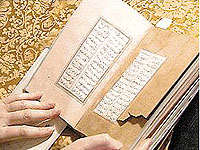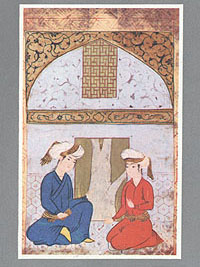 |
|
Uzbekistan - Literature |
|||
|
The most ancient samples of the Uzbek literature concern to poetic creativity, integral part of culture of the Uzbek people. The large place belongs to fair)' tales such as about the animals, magical- fantastic themes and household stories. Among the latter a latifa ('jokes') genre is developed. The national imagination created a collective image of Nasriddin Afandi, the main hero and wise character of Uzbek national jokes. The largest genre of the Uzbek folklore is dastan ('poem'). It was executed usually in support of musical tools. There are more than 300 dastans (100 plots) were written down. The brightest samples are: the heroic epic of"Alpomysh", heroic- romantic epic of "Gur-ughli" (more than 40 plots), military epic "Ynsuf and Akhmad", "Tokhir and Zukhra", and others. The book version, as a rule, was borrowed from classical products "Farkhod and Shirin", "Layli va Majnun". Pre-Islamic culture is represented by insignificant number of written monuments in Old Turkic languages: "Penitential prayer of Manicheans" (the 5th century) and Orkhun-Yenisey writings (7-12th centuries), "Kutadghu-Bilig" ('knowledge', 'giving happiness') (1069) of Yusuf Bolosoghuny, "Khibatul Khakaik" ('a souvenir of truths') by Akhmad Yugnaky, and especially, Devoni Lughati Turk ('dictionary of the Turkic languages) (1072-74) by Makhmud Kashghary are among the finest examples of Uzbek literature. Since the 14th century the Uzbek literature developed intensively and rather diverse. The period saw the emergence of a secular theme (a love epic with Biblical- Quranic topic, "Yusufand Zulaykho" by Durbek in l4-15th centuries.) Also, the most blooming period of Uzbek literature came on the scene during the period of Amir Temur. Diverse forms of brilliant poetic works achieved the special popularity. Compositions by Akhmad Yassavy, Akhmad Yugnaky and Khorazmy were widely popular among the public. Amir Temur himself highly respected Yassavy for his geniality, and built a majestic monument on his grave. Special attention on the part of Amir Temur towards literature and arts has become a fair tradition to the entire Temur dynasty. Uzbek literature of that period served a significant stage in its historical development. Humanitarian values and great ideas are still urgent in it, and still preserved their value. One of the bright lyric poets of the 15th century was Lutfy, who in his poems used to highlight an ideal love, Poems by Atai and Sakkakv are also among brilliant examples. And, certainly, the special place belongs to works by Alisher Navoi. He combined his lyrics in four collections, including kasidas, gazek kitas, rubais and others.
The cornerstone of his poetry is "Khamsa" ("Five stories"). In the anthology "The Assembly of Scientists" Navoi briefly describes famous poets of the 15th century. Also, in his many works he talked about theories of ethics and aesthetics. His treatise, namely "Weight of the sizes" served a significant development in Uzbek lyrics. In the 16th century numerous literary and historical works as well as their translations into Uzbek language were produced. Historical events of the 16th century were told in "Shayboniynoma"(1506), as well as in the works by Zakhiriddin Muhammad Bobur, who is said to have led records throughout his life, which later had become a source for his autobiographical work, entitled "Boburnama", a remarkable literary and historical essay. Later on, works by Turdi (Faroghy), Mashrab and other poets saw large popularity. The influence of folklore upon the written literature was on the rise. Many topics for legends served a basis for creation of large literary works (poems Yusufand Zubykbo by Nozim Khisrav, "Tokhir and Zukhra" by Sayyodi, "Bakhrom and Gulandom" by Saykali, and others). |

